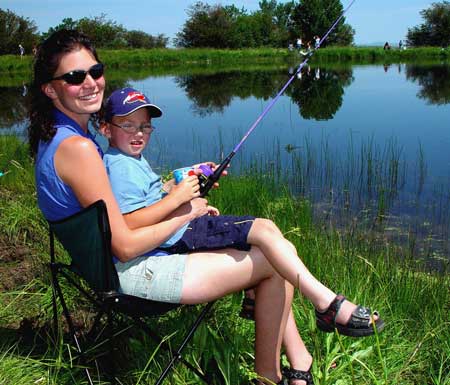Private Fish Ponds

- Application For Private Pond Permit - [PDF, 38 KB]
- Application For Live Fish Transport/Import - [PDF, 34 KB]
- Application For Grass Carp Transport/Import - [PDF, 120 KB]
What is a private fish pond?
A pond is defined as private only if it is entirely surrounded by private land and is not located on a natural stream channel. Stocking or maintaining fish in such a pond requires a Private Pond Permit. Any lake, pond, or reservoir with legal access to the public is considered a public water body. The Idaho Department of Fish and Game (IDFG) manages the fisheries on public waters.
Why are private fish ponds regulated?
Private fish ponds have been popular on farms across rural America for decades. They can provide fishing enjoyment for kids and an opportunity for pond owners to create and manage their own personal fisheries. However, if not regulated, private fish ponds have the potential to seriously harm wild fish populations in adjacent rivers, streams, and lakes. Unwanted non-native fish species, non-native frogs (bull frogs), diseases, and aquatic invasive species such as quagga or zebra mussels can be easily introduced to drainages through private ponds. For this reason, IDFG works with landowners and other agencies to ensure private pond stocking won't harm public fisheries.
A valid Private Pond Permit grants the landowner the right to apply their own fishing regulations to their fish pond. State fishing licenses are not required to fish permitted private ponds.
What are the requirements?
- The pond must be entirely on the owner or leases property.
Before stocking fish, a landowner or leasee must obtain a Private Fish Pond Permit.
Private Fish Pond Permits insure that the pond owner has met the necessary requirements for fish or bullfrog stocking. In addition, the permits allow IDFG to monitor and prevent introductions of fish that could harm wild populations. These free permits must be renewed every five years. The first step in acquiring a Private Fish Pond Permit is to complete an Application for Private Pond Permit. Applications can also be obtained from Fish & Game regional offices.
The outlet and inlet (if applicable) to the pond must be screened.
Before a permit can be issued, landowners must screen the outlet of their pond to ensure that fish cannot escape into public waters from the pond. The inlet may also require screening to keep wild fish from entering the pond. Depending on the location of the pond and the risk of escapement, a Conservation Officer may inspect the pond and ensure the screening is sufficient.
The size of the mesh depends on the size and species of fish they intend to stock. Ponds stocked with fish that will reproduce in the pond, such as bass or bluegill, require a smaller mesh than ponds that will be stocked only with large trout.
Only approved species of fish from approved hatcheries may be stocked.
Even the best screens may fail. For this reason IDFG only allows stocking of desirable species that are currently found in adjacent waters. This ensures that new species aren't introduced into publicly owned waters, threatening native fish populations and public fishing opportunity. Additionally, to prevent cross-breeding between escaped rainbow trout and native cutthroat trout, only sterilized (triploid) rainbow trout or native cutthroat trout are allowed in many areas. If you live in one of the shaded areas of the map, you may be prohibited from stocking fertile rainbow trout. To prevent the introduction and spread of disease, such as whirling disease, only fish from an approved, disease-free hatchery may be stocked.
If the fish being stocked are considered “invasive” under Idaho rules, or coming from a location known to harbor invasive species, you will need to work with the Idaho State Department of Agriculture (208-332-8540) and their permitting process for transportation of invasive species.
Records must be kept of when fish are stocked and the source of the fish.
To protect you and our native fish, we may want to do disease testing to verify the health or genetic background of your fish. We require you to keep five (5) years worth of fish stocking records for your pond.
Where can pond owners acquire fish?
Fish may be purchased at one of several commercially licensed fish hatcheries located in Idaho or adjacent states. The hatcheries must be approved disease-free facilities and must be licensed by the Idaho State Department of Agriculture (IDA). Contact the IDA for the name of fish growers who sell fish to private pond owners at (208) 332-8540.
Under certain circumstances, pond owners may collect fish for their own ponds if they obtain a Live Fish Transport Permit. These permits, which cost $23.50 for residents, will only be approved for transfer of fish that meet the requirements of the Private Pond Permit. Anyone collecting fish from public waters must have a valid fishing license and abide by the regulations established for those waters. At no time can live fish be transported without a permit. Contact the local Fishery Manager in your region for an application.
